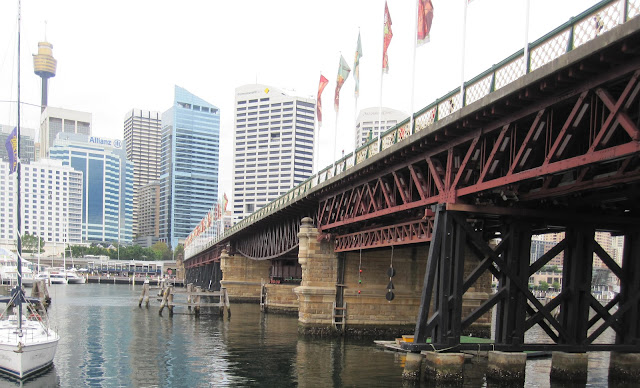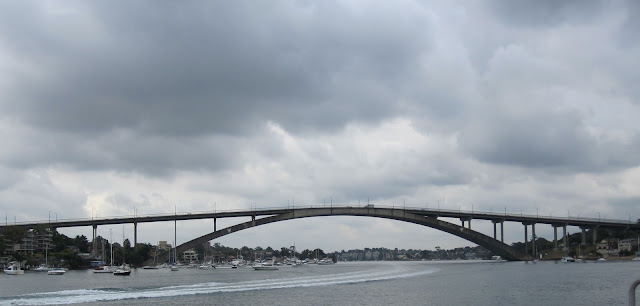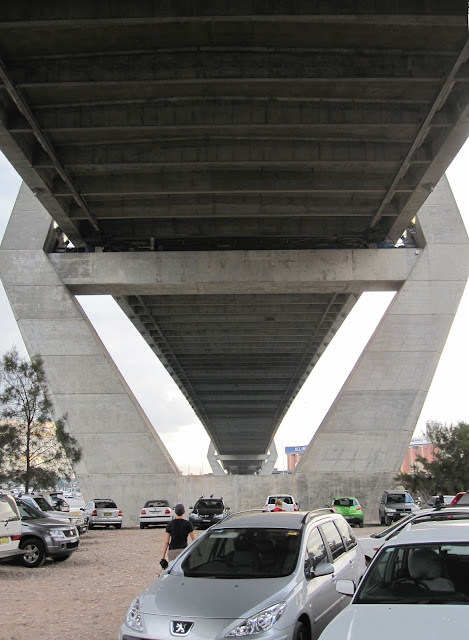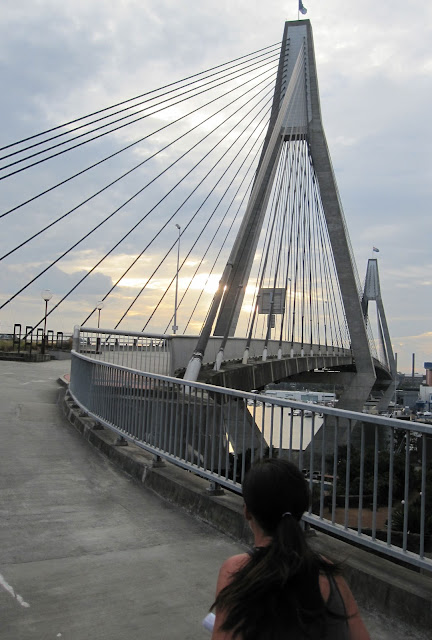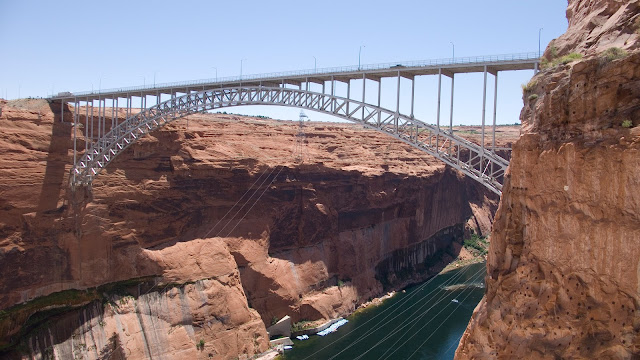 |
March 2011 (-33.830 deg., 151.146 deg.) Fig Tree Bridge Sydney's Seven Bridges Walk includes the Harbour Bridge, the Pyrmont Bridge, the ANZAC Bridge, the Iron Cove Bridge, the Gladesville Bridge, the Tarban Creek Bridge, and the Fig Tree Bridge, which carries Burns Bay Road over the Lane Cove River. The Fig Tree Bridge was built in 1963 and replaced a 19th century movable bridge with the same name. The new bridge has a seven span steel girder superstructure and reinforced concrete two column bents (with extra wide bent caps for an expressway that was never built). Despite only carrying a road, this bridge often provides a faster way in and out of Sydney than going the other way around over the Harbour Bridge. Australia's Bridges: Fig Tree Bridge in New South Wales by Mark Yashinsky is licensed under a Creative Commons Attribution-NonCommercial-NoDerivs 3.0 Unported License. |
Thursday, March 31, 2011
Australia's Bridges: Fig Tree Bridge in New South Wales
Wednesday, March 30, 2011
Australia's Bridges: Pyrmont Bridge in Sydney, Australia (3)

Australia's Bridges: Pyrmont Bridge in Sydney, Australia (3) by Mark Yashinsky is licensed under a Creative Commons Attribution-NonCommercial-ShareAlike 3.0 United States License.
Tuesday, March 29, 2011
Australia's Bridges: Sydney Harbour Bridge (3)

Australia's Bridges: Sydney Harbour Bridge (3) by Mark Yashinsky is licensed under a Creative Commons Attribution-NonCommercial-NoDerivs 3.0 Unported License.
Monday, March 28, 2011
Australia's Bridges: Brickpit Ring Bridge in Sydney's Olympic Park (2)

Australia's Bridges: Brickpit Ring Bridge in Sydney's Olympic Park (2) by Mark Yashinsky is licensed under a Creative Commons Attribution-NonCommercial-ShareAlike 3.0 United States License.
Sunday, March 27, 2011
Australia's Bridges: Brickpit Ring Bridge in Sydney's Olympic Park (1)

Australia's Bridges: Brickpit Ring Bridge in Sydney's Olympic Park (1) by Mark Yashinsky is licensed under a Creative Commons Attribution-NonCommercial-ShareAlike 3.0 United States License.
Saturday, March 26, 2011
Australia's Bridges: Pyrmont Bridge in Sydney (2)

Australia's Bridges: Pyrmont Bridge in Sydney (2) by Mark Yashinsky is licensed under a Creative Commons Attribution-NonCommercial-ShareAlike 3.0 United States License.
Friday, March 25, 2011
Australia's Bridges: Glebe Island Bridge in New South Wales

Australia's Bridges: Glebe Island Bridge, Rozelle Bay by Mark Yashinsky is licensed under a Creative Commons Attribution-NonCommercial-ShareAlike 3.0 United States License.
Thursday, March 24, 2011
Australia's Bridges: Pyrmont Bridge in Sydney, (1)

Australia's Bridges: Pyrmont Bridge in Sydney (1) by Mark Yashinsky is licensed under a Creative Commons Attribution-NonCommercial-ShareAlike 3.0 United States License.
Wednesday, March 23, 2011
Australia's Bridges: Sydney Harbour Bridge (2)

Australia's Bridges: Sydney Harbour Bridge (2) by Mark Yashinsky is licensed under a Creative Commons Attribution-NonCommercial-NoDerivs 3.0 Unported License.
Tuesday, March 22, 2011
Australia's Bridges: Sydney Harbour Bridge (1)

Australia's Bridges: Sydney Harbour Bridge (1) by Mark Yashinsky is licensed under a Creative Commons Attribution-NonCommercial-NoDerivs 3.0 Unported License.
Monday, March 21, 2011
Australia's Bridges: Iron Cove Bridge in New South Wales (2)

Australia's Bridges: Iron Cove Bridge in New South Wales (2) by Mark Yashinsky is licensed under a Creative Commons Attribution-NonCommercial-NoDerivs 3.0 Unported License.
Sunday, March 20, 2011
Australia's Bridges: Iron Cove Bridge in New South Wales (1)

Australia's Bridges: Iron Cove Bridge in North South Wales (1) by Mark Yashinsky is licensed under a Creative Commons Attribution-NonCommercial-NoDerivs 3.0 Unported License.
Saturday, March 19, 2011
Australia's Bridges: Tarban Creek Bridge in New South Wales (2)
| March 2011 (-33.839 deg., 151.146 deg.) Tarban Creek Bridge |
Between the Gladesville Bridge and the Tarban Creek Bridge is this connector ramp with attractively shaped pier walls. I also like the long overhangs on the superstructure. I think even the she-bolt holes in the piers add to this connector's appearance.

Australia's Bridges: Tarban Creek Bridge in New South Wales (2) by Mark Yashinsky is licensed under a Creative Commons Attribution-NonCommercial-NoDerivs 3.0 Unported License
Friday, March 18, 2011
Australia's Bridges: Tarban Creek Bridge in New South Wales (1)
| March 2011 (-33.837 deg., 151.145 deg.) Tarban Creek Bridge The Tarban Creek Bridge is a reinforced concrete multi-span bridge with what I would call a deck-stiffened arch over the creek. It was built about the same time as the Gladesville Bridge (to the south) and the Fig Tree Bridge (to the north) for an expressway project that never came to fruition. I think it's a little disingenuous that they advertise a 'Seven Bridges Walk' when tall fences surround one of the bridges (I took this photo through one of the fence links). |

Australia's Bridges: Tarban Creek Bridge in New South Wales (1) by Mark Yashinsky is licensed under a Creative Commons Attribution-NonCommercial-NoDerivs 3.0 Unported License.
Thursday, March 17, 2011
Australia's Bridges: Gladesville Bridge in New South Wales (2)

Australia's Bridges: Gladesville Bridge in New South Wales (2) by Mark Yashinsky is licensed under a Creative Commons Attribution-NonCommercial-NoDerivs 3.0 Unported License.Publish Post
Wednesday, March 16, 2011
Australia's Bridges: Gladesville Bridge in New South Wales (1)

Australia's Bridges: Gladesville Bridge in New South Wales (1) by Mark Yashinsky is licensed under a Creative Commons Attribution-NonCommercial-NoDerivs 3.0 Unported License.
Sunday, March 13, 2011
Australia's Bridges: ANZAC Cable-Stayed Bridge (4) in Sydney

Australia's Bridges: ANZAC Cable-Stayed Bridge (4) in Sydney by Mark Yashinsky is licensed under a Creative Commons Attribution-NonCommercial-NoDerivs 3.0 Unported License.
Saturday, March 12, 2011
Australia's Bridges: Anzac Cable-Stayed Bridge (3) in Sydney

Australia's Bridges: Anzac Cable-Stayed Bridge (3) in Sydney by Mark Yashinsky is licensed under a Creative Commons Attribution-NonCommercial-NoDerivs 3.0 Unported License.
Friday, March 11, 2011
Australia's Bridges: Anzac Cable-Stayed Bridge (2) in Sydney
The ANZAC Bridge has a steep ramp that carries runners and cyclists onto the side span. I think the runners enjoy the 'burn' but they are constantly at risk from the furiously pedaling cyclists.

Australia's Bridges: Anzac Cable-Stayed Bridge (2) in Sydney by Mark Yashinsky is licensed under a Creative Commons Attribution-NonCommercial-NoDerivs 3.0 Unported License.
Thursday, March 10, 2011
Australia's Bridges: ANZAC Cable-Stayed Bridge in Sydney (1)
Just west of Downtown Sydney (crossing a little inlet south of the harbor) is a big cable-stayed bridge. Sydney must have a lot of money to spend on infrastructure. There's the monorail, street cars, a light rail system, a heavy rail system, and lots of bridges.
ANZAC stands for the Australian and New Zealand Army Corps who fought and died bravely during WWI, and there are many bridges and other monuments to these soldiers in both countries.
This is one of the widest cable-stayed bridges (at 106 ft) I've come across. Also, it appears to be hanging freely from the towers without any kind of bearings or dampers (although I may have missed them).
We'll take another look at this bridge tomorrow.
ANZAC stands for the Australian and New Zealand Army Corps who fought and died bravely during WWI, and there are many bridges and other monuments to these soldiers in both countries.
This is one of the widest cable-stayed bridges (at 106 ft) I've come across. Also, it appears to be hanging freely from the towers without any kind of bearings or dampers (although I may have missed them).
We'll take another look at this bridge tomorrow.

Australia's Bridges: Anzac Cable-Stayed Bridge (2) in Sydney by Mark Yashinsky is licensed under a Creative Commons Attribution-NonCommercial-NoDerivs 3.0 Unported License.
Wednesday, March 9, 2011
Australia's Bridges: Hay Street Railroad Bridge in Sydney
Greetings from Sydney Australia. This railroad bridge over Hay Street carries trains in and out of Sydney's Central Station. I like the reddish tint of the stone.

Australia's Bridges: Hay Street Bridge in Sydney by Mark Yashinsky is licensed under a Creative Commons Attribution-NonCommercial-NoDerivs 3.0 Unported License.
Tuesday, March 8, 2011
Arizona's Bridges: Glen Canyon Dam Bridge (2)

Arizona's Bridges: Glen Canyon Dam Bridge (2) by Mark Yashinsky is licensed under a Creative Commons Attribution-NonCommercial-NoDerivs 3.0 Unported License.
Monday, March 7, 2011
Arizona's Bridges: Glen Canyon Dam Bridge (1)
I have more ambivalent feelings about this Arizona bridge, not only because it was used to dam the Colorado River, but because I got a $500 ticket just before the bridge for crossing a double line to pass a recreational vehicle.
The Glen Canyon Dam Bridge was built in 1959. It's 1560 ft long and about 700 ft above the river. It looks a little bit like the new Navajo Bridge but with simple steel columns between the arch and the deck. We'll take another look at the bridge tomorrow.

Arizona's Bridges: Glen Canyon Dam Bridge (1) by Mark Yashinsky is licensed under a Creative Commons Attribution-NonCommercial-NoDerivs 3.0 Unported License.
Arizona's Bridges: Navajo Bridge (5)
A view of the old Navajo Bridge with a stone retaining wall on the southeast side.

Arizona's Bridges: Navajo Bridges (5) by Mark Yashinsky is licensed under a Creative Commons Attribution-NonCommercial-NoDerivs 3.0 Unported License.
Saturday, March 5, 2011
Arizona's Bridges: Navajo Bridge (4)
Before the first Navajo Bridge was built in 1929, the only way across the Colorado River for hundreds of miles was a dangerous ferry ride. The original bridge (on the right) was too narrow and had a dangerous bend at the east end that caused accidents. The new bridge was built in 1994 and the old bridge was turned into a pleasant foot (and equestrian) bridge. The old arch span was 616 feet long and the new arch span is 726 feet long. Both bridges are about 500 feet above the Colorado River. They're located just south of Utah across from the aptly-named Vermillion Cliffs.

Arizona's Bridges: Navajo Bridges (4) by Mark Yashinsky is licensed under a Creative Commons Attribution-NonCommercial-NoDerivs 3.0 Unported License.

Arizona's Bridges: Navajo Bridges (4) by Mark Yashinsky is licensed under a Creative Commons Attribution-NonCommercial-NoDerivs 3.0 Unported License.
Subscribe to:
Posts (Atom)



